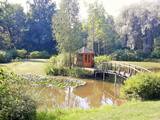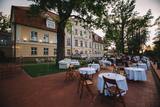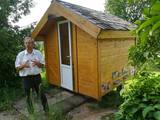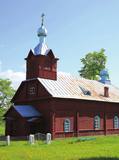| Nr | Name | Beschreibung |
|---|---|---|
|
Das Café befindet sich unweit vom Bahnhof. Im Keller werden gastronomische Waren hergestellt, im Erdgeschoss befinden sich ein Geschäft und das Café. Hier werden einstöckige und mehrstöckige Torten, Kuchen (Cremeschnitten, Apfelkuchen, Kuchen Vecriga (Altstadt von Riga), Honigkuchen, Brötchen mit Sahnefüllung, Rollkuchen), Brötchen (Zimt-, Mohn-, Quarkbrötchen), Piroggen (Käsehörnchen, Käsefladen, Speckfladen, Fladen von Riga) und Kringel gebacken und Fleischauslese und salzige Vorspeisen angeboten. |
||
|
Das Militärobjekt gewährleistete die Funktionen des Auffangens und der Kontrolle der Funkverbindung. Heutzutage ist die Station der Funkverbindung der Kriegsflote im Besitz von dem Abwehrministerium. Für die Zivilpersonen ist das Objekt nur von Außen zugänglich.
|
||
|
Brīvdienu māja "Jasmīnu nams" atrodas pie pašas Jelgavas robežas - tikai 7 minūšu braucienā līdz pilsētas centram. Brīvdienu māja ir lieliska vieta mierpilnam dabas baudījumam, kas rit roku rokā ar iespēju stiprināt veselību pirtī vai alternatīvā SPA - āra kublā. Brīvdienu mājā ir 3 istabas, savrupa teritorija vienai līdz divām mājsaimniecībām – līdz 6 personām, īpašu uzsvaru liekot uz atpūtu kopā ar bērniem. Nav paredzēts skaļām ballītēm un jauniešu tusiņiem. Namiņā ir viss nepieciešamais maltītes pagatavošanai gan iekšā, gan ārā svaigā gaisā. Tuvumā atrodas Svētes upe un atpūtas zona - Svētes palienes pļavu koka laipu celiņu tīkls. |
||
|
Einer der ältesten botanischen Parks in Litauen. 1928 begann I. Navidanskas, der zu dem Zeitpunkt erst 16 war, mit der Gestaltung des Parks. 1965 wurde der Park als Niederlitauischer Botanischer Park benannt. Izidorius Navidanskas entwickelte den Park zusammen mit seinem Sohn Rapolas Navidanskas, der gegenwärtig Besitzer des Parks ist, weiter. |
||
|
Eine kleine Bierbrauerei und ein Laden in Lielvārde. Es werden Verkostungen organisiert sowie angeboten, in Lettland hergestellte Köstlichkeiten vor Ort zu probieren oder zum Mitnehmen zu kaufen. |
||
|
This park was established to protect Lithuania’s longest lake, Lake Asveja (> 20 km). The lake is in a sub-glacial valley carved out by ice during the Ice Age, and it actually resembles a wide and curvy river.
|
||
|
Ein mannigfaltiger Waldbestand, der durch die Vidzemer Straße und die Eisenbahnlinie Rīga-Lugaži halbiert ist. Das ist das Gebiet, in dem der am meisten gefährdete Vogel der Welt – die Blauracke – gefunden wird. Zwischen ¼ und 1/5 des lettischen Bestandes an Krähen findet man hier. Es ist auch eines der letzten Nistgebiete des Grünspechtes.
|
||
|
Darbnīcā tiek izgatavoti personalizēti pulksteņi un dažādi dizaina priekšmeti no koka, kā arī piedāvātas kokapstrādes meistarklases vai klātbūšana dažādos materiāla pirmsapstrādes vai finiša apstrādes procesos. Tāpat iespējama ekskursija pa darbnīcu un koku sugu atpazīšanas viktorīna. |
||
|
Das Restaurant befindet sich in dem 2008 renovierten Gebäude des Landguts Mālpils, das als Baudenkmal des Klassizismus aus dem 19. Jh. gilt. Die Speisekarte des Restaurants wird ständig geändert und mit saisonalen Gerichten ergänzt. Eine Kombination aus feinen Geschmäcken und einem eleganten Ambiente des Landguts. Lettische Küche: Käse von Mapils, Pilzsuppe, Wildbret, gebratener Zander, Roggenbrot-Dessert. Das besondere Gericht: Eis des Landgutes von Malpils. |
||
|
Atrodas Cēsu rietumdaļā – pie ceļa, kas ved uz Cīrulīšiem. Piedāvājumā – plašs ēdienu klāsts no brokastīm līdz vakariņām. |
||
|
В1699 в центре Нюкши Пасиенские доминиканские монахи построили часовню, на месте которой в 1765 году помещик Хилзен возвел новую церковь. Помещения были маленькие, и в 1922 - 1926 гг. на фундаменте старой церкви строится новая и большая – теперешняя церковь, которую называют одним из самых красивейших деревянных храмов Латгалии. В здании находится центральный алтарь работы второй четверти XVIII века и два боковых алтаря работы примерно 1700 г. Церковь можно осмотреть изнутри. |
||
|
Dieser Ort befindet sich am nordöstlichen Ufer des Sees Razna. Die Wirtin bietet lettgallische Gerichte, interaktive Lehrveranstaltungen für die Erkundung der Umwelt und Dienstleistungen des Reiseleiters an. Lettische Küche: Gerichte aus Süßwasserfischen: Geräucherte Fische, Schleien in Sauerrahmsoße, im Öl gebratene Barschen, im Ofen gebackene Brachse, gefüllter Hecht und andere Gerichte, die aus lokalen Produkten vorbereitet werden. Das besondere Gericht: Auf offenem Feuer gekochte Suppe aus den Fischen aus dem See Razna. |
||
|
"Piebalga medus" is located in Vecpiebalga region, turning off the highway Cēsis – Vecpiebalga – Madona (P30). Beekeeping, apitherapy and narration "About and around bees". Tasting and purchase of beekeeping products. A candlestick workshop is available for visitors. Especially with the fact that the apiary only with Latvian hives. |
||
|
Kneipe von Mulgi befindet sich im Zentrum von Mulgimaa in Abja-Paluoja. Es ist eine gemütliche Gaststätte mit traditioneller lokalen Küche und netter Bedienung. Das renovierte Gebäude selbst ist über 100 Jahre alt. |
||
|
Tiskādi Old-Believers Prayer House was built in 1886 and reconstructed
in 1905. The large church was sanctified 100 years ago. It is situated in the district which is mostly populated by Old Believers. The church stands on the hill.
|
||
|
Dodieties ekskursijā, lai gūtu ieskatu lauku profesijā un dzīvesveidā, kā arī iegūtu jaunus iespaidus un labu atpūtu visai klasei. Ekskursijas laikā apmeklējiet etnogrāfisku ciematu un muzeju, kurā var iepazīt vecticībnieku kultūrvidi un tradīcijas. Pēc tam apmeklējiet saimniecību, lai uzzinātu par dažādiem ārstniecības augiem un degustētu tējas. Ekskursijas noslēgumā dodieties uz zirgu sētu, kur var iepazīt saimniecību, tās galvenos iemītniekus - zirgus, kā arī izstaigāt dabas taku. |
||
|
This is the thickest birch (Betula pendula) tree in Latvia and can be seen from the Klapkalnciems-Milzkalne road.
|
||
|
0,2 km austrumos no Vidsmuižas atrodas no šķeltajiem laukakmeņiem un sarkanajiem ķieģeļiem celtā (1910. - 1912. g.) Vidsmuižas katoļu baznīca. Tāpat kā Riebiņos esošā, arī šī ir uzskatāma par tipisku 19. – 20. gs. mijas Latgales lauku baznīcas paraugu. |
||
|
The Ludza castle hill offers one of the most interesting views in Latgale – that of the oldest town in Latvia and its historical centre, Great Lake Ludza and Small Lake Ludza, the ruins of the castle of the Livonian Order, Baznīckalns hill, churches, the regional research museum, the craftsmen’s centre, etc.
|
||
|
Früher Pize, livisch Pizā. Der jetzige Name stammt von dem während der Kaiserzeit erbauten Leuchtturm (Michailowski Majak), der im Namen des Neffen des alten Kaisers Alexander II. genannt wurde. Der heute bestehende Leuchtturm – insgesamt der dritte – Miķeļbāka wurde 1957 erbaut und ist der höchste Leuchtturm in Lettland : 57 m hoch (nur von außen zu besichtigen). Die lutherische Kirche von Miķeļtornis wurde 1893 erbaut. In der Nähe kann man das 1857 erbaute Gebäude des Wirtshauses von Pize (in schlechtem Zustand) mit der für das 19. Jahrhundert typischen Planung und Konstruktion sehen, das als einziges an der Livischen Küste gilt. In Miķeļtornis wurde der erste livische Kulturarbeiter Jānis Princis (1796–1868) geboren, der zusammen mit seinem Sohn Jānis das Evangelium nach Matthäus in den westlichen Dialekt der kurländisch-livischen Sprache übersetzt hat. J. Princis Senior und J. Princis Junior waren auch Autoren der 1845 herausgegebenen Dichtung „Geistliche Lieder und Gebete der Seemänner“. Vorher wurde ein lettisches Dichtungsbuch nur vom Blinden Indrick herausgegeben. Auf dem Bauernhof Olmaņi in Miķeļtornis wird ein Schüler des Künstlers Vilhelms Purvītis, der livische Maler Andrejs Šulcs (1910–2006), geboren. Auf dem Friedhof von Miķeļtornis wird 1978 ein Denkmal für livische Dichter (das erste Denkmal für Liven) eröffnet. Es ist geplant, bis 2019 im Dorfzentrum das Kunstobjekt des Künstlers Ģirts Burvis „Jahrhundert der Segelschiffe“ zu eröffnen. |
||























